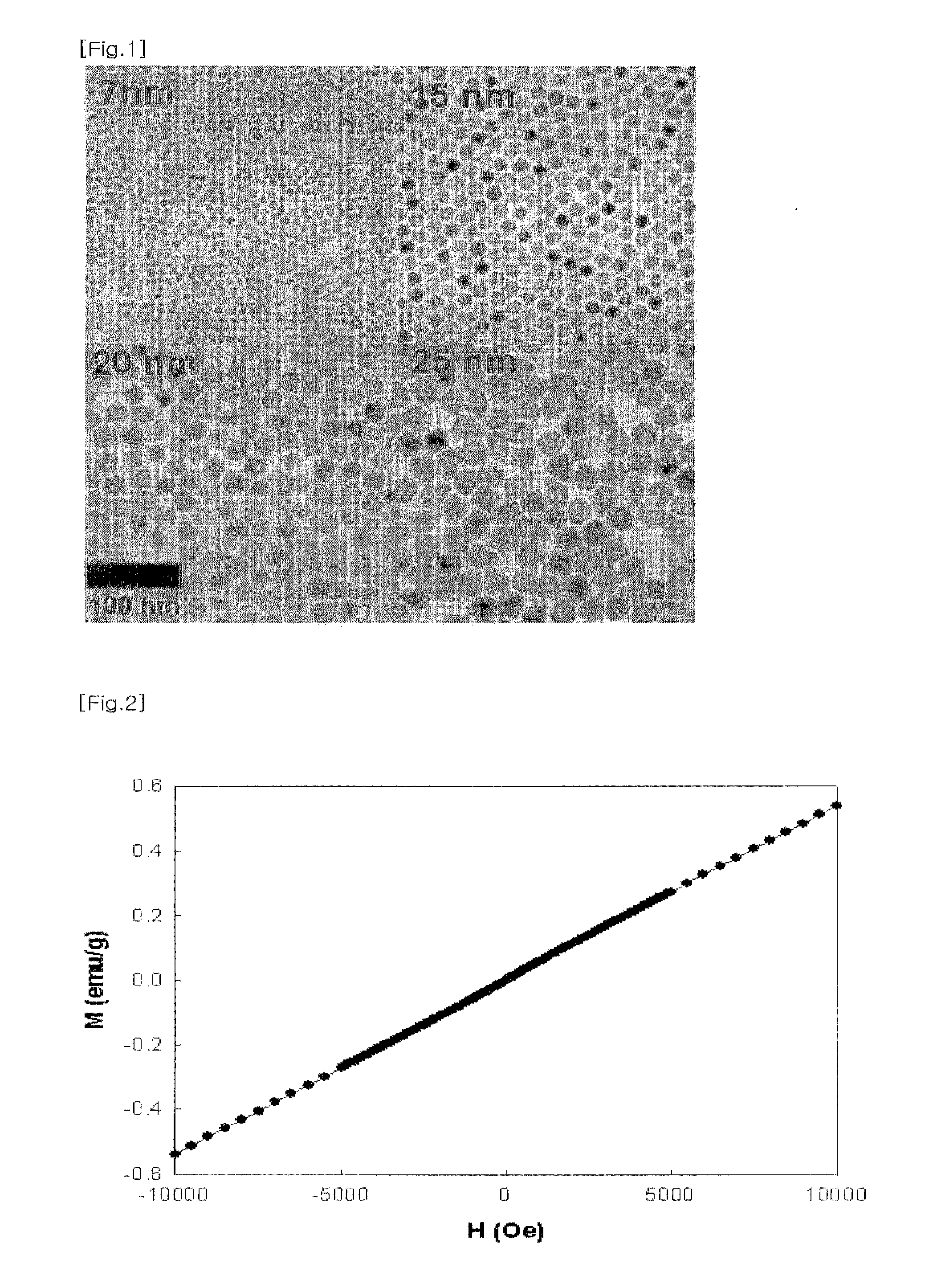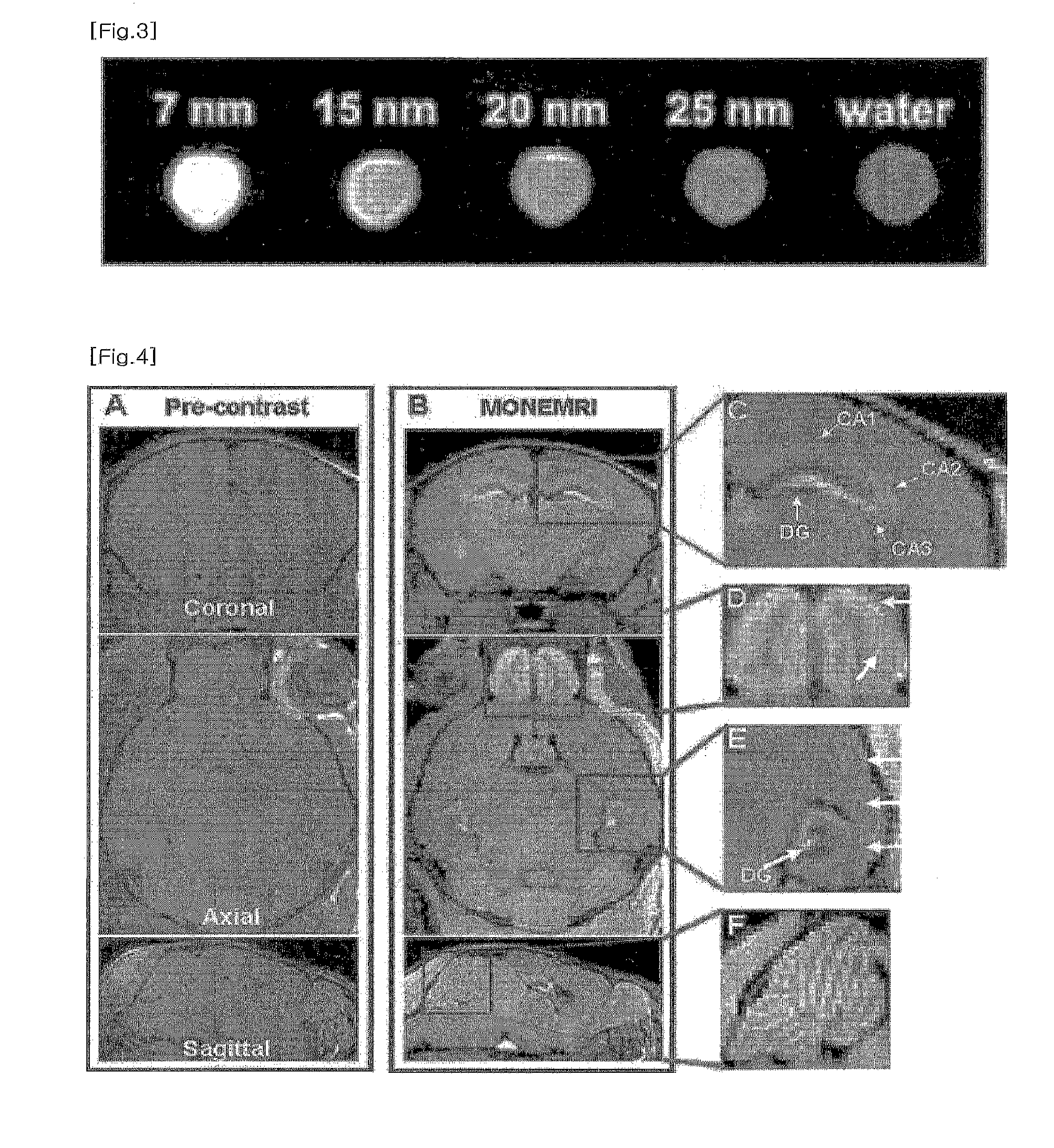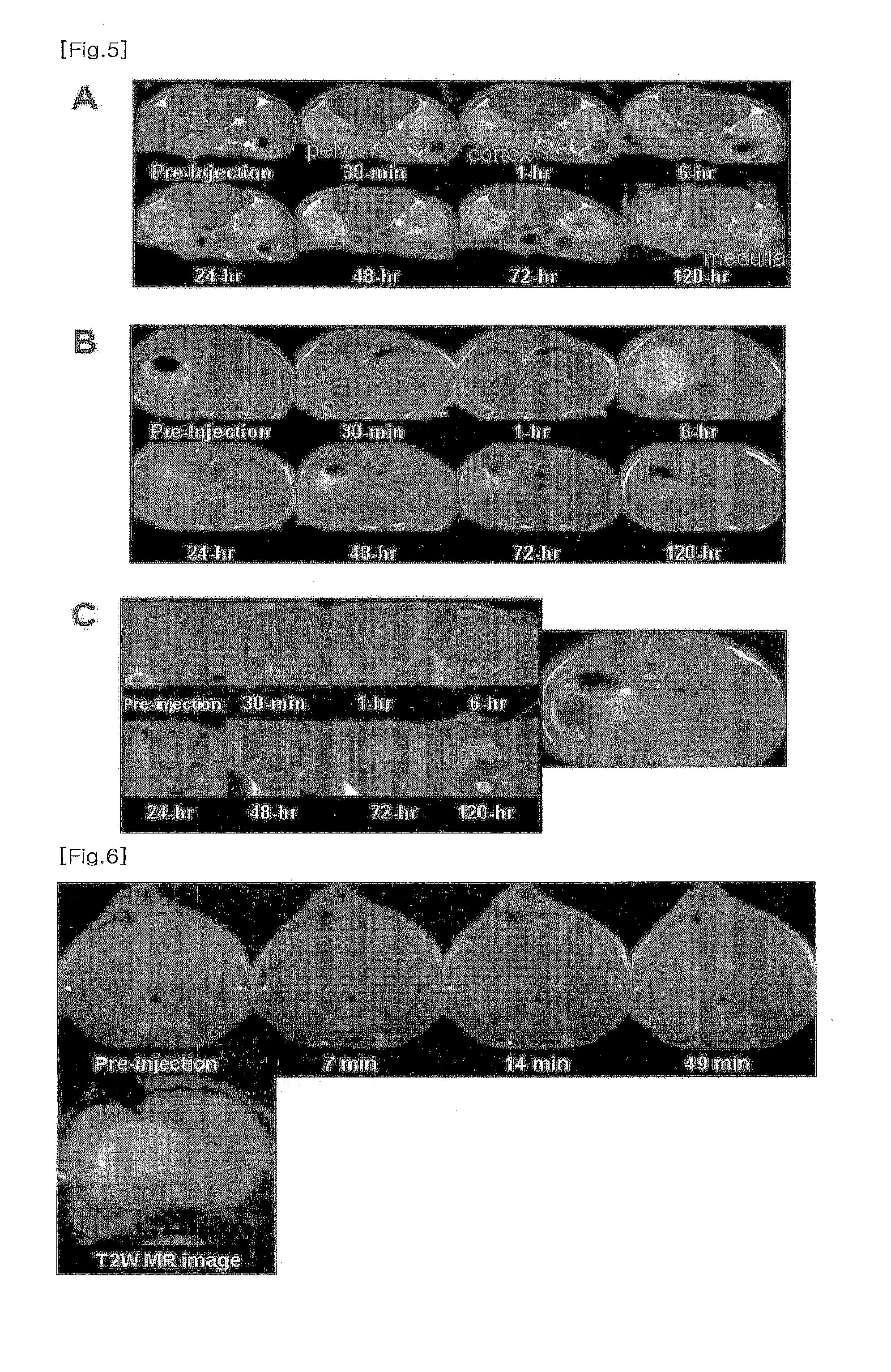MRI t1 contrasting agent comprising manganese oxide nanoparticle
a manganese oxide nanoparticle and contrasting agent technology, applied in the field of mno nanoparticles as mri t1 contrasting agent, can solve the problems of insufficient amount of contrasting brain or other, insufficient amount of mri, and toxicity of gadolinium ion, so as to remove the toxicity of mn2+, and improve the effect of contrasting brain and other aspects
- Summary
- Abstract
- Description
- Claims
- Application Information
AI Technical Summary
Benefits of technology
Problems solved by technology
Method used
Image
Examples
example 2
Biocompatibility and Contrast Ability of MnO Nanoparticles Coated with PEG
[0082]The sizes of nanoparticles prepared in Example 1 were very uniform and could be controllable. Also, the nanoparticles were biocompatible due to the coating with PEG, and stable over several months.
[0083]When the size of the MnO nanoparticle including a biocompatible material layer was more than 500 nm, the MnO nanoparticle coated with a biocompatible material was degraded by the immune system or in the liver, and thus residence time of the MnO nanoparticle in a living organism was decreased, resulting in decrease in MRI scanning time. Therefore, the size of the MnO nanoparticle including a biocompatible material layer should be preferably no more than 500 nm and more preferably no more than 100 nm.
[0084]The contrast ability of MnO nanoparticles for MRI were tested with 3.0 T clinical MRI system. As shown in FIG. 2, the MnO nanoparticles at the concentration of 5 mM clearly showed bright signal enhancemen...
example 3
Manganese Oxide Nanoparticles Enhanced MR Imaging (MONEMRI)
[0085]MONEMRI of a mouse was observed by using the MnO nanoparticles of the present invention. The MRI experiment was carried on a 4.7T / 30 MRI system (Brucker-Biospin, Fallanden, Switzerland). The 25 nm sized MnO nanoparticles were bolus injected to a mouse through a tail vein, for the in vivo MRI imaging. The experimental conditions were as follows:
[0086]3-1. MRI Imaging Conditions of Brain
[0087]fast spin-echo T1-weighted MRI sequence
[0088]TR / TE=300 / 12.3 ms
[0089]echo train length=2
[0090]140 m 3D isotropic resolution
[0091]FOV=2.56×1.28×1.28 cm3
[0092]matrix size=256×128×128
[0093]3-2. MRI Imaging Conditions of Abdomen
[0094]fast spin-echo T1-weighted MRI sequence
[0095]TR / TE=400 / 12 ms
[0096]NEX=16
[0097]slice thickness=1.5 mm
[0098]FOV=2.78×168 cm2
[0099]matrix size=192×192
[0100]The resulting excellent MRI images of the mouse brain (FIG. 4) depicting fine anatomic structure were obtained, comparing with the MRI images without the ...
example 4
Preparation of Targeting Probe Conjugated MnO Nanoparticles
[0102]Target specific probe conjugated MnO nanoparticles were prepared by the following two steps.
[0103]4.1 Synthesis of MnO Nanoparticles Having Reactive Functional Groups
[0104]At the step of coating the MnO nanoparticles dispersed in an organic solvent with biocompatible poly(ethylene glycol) in Example 1, the MnO nanoparticles were coated with phospholipids including PEG of which end was functionalized by reactive groups such as amine (—NH2), thiol (—SH), carboxylate (—CO2—), etc. For example, the MnO nanoparticles were coated with a mixture of 1,2-distearoyl-sn-glycero-3-phosphoethanolamine-N-[methoxy(polyethylene glycol)-2000] (mPEG-2000 PE, Avanti Polar Lipids, Inc.) and 1,2-distearoyl-sn-glycero-3-phosphoethanolamine-N-[maleimide(polyethylene glycol)-2000] (DSPE-PEG(2000) Maleimide, Avanti Polar Lipids, Inc.) in order to endow the MnO nanoparticles with maleimide. The method was similar to that of Example 1.
[0105]4.2 ...
PUM
| Property | Measurement | Unit |
|---|---|---|
| diameter | aaaaa | aaaaa |
| diameter | aaaaa | aaaaa |
| diameter | aaaaa | aaaaa |
Abstract
Description
Claims
Application Information
 Login to View More
Login to View More - R&D
- Intellectual Property
- Life Sciences
- Materials
- Tech Scout
- Unparalleled Data Quality
- Higher Quality Content
- 60% Fewer Hallucinations
Browse by: Latest US Patents, China's latest patents, Technical Efficacy Thesaurus, Application Domain, Technology Topic, Popular Technical Reports.
© 2025 PatSnap. All rights reserved.Legal|Privacy policy|Modern Slavery Act Transparency Statement|Sitemap|About US| Contact US: help@patsnap.com



